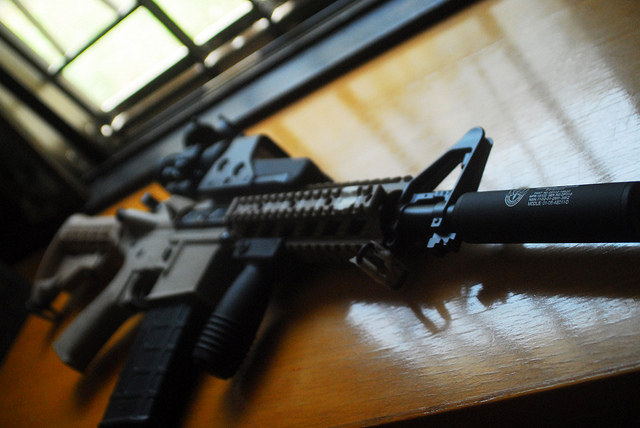Wednesday, October 4th 2017 (WASHINGTON) – As a result of routine drilling from childhood to adulthood, the majority of Americans know what to do in the event of a fire, whether it’s following a pre-planned exit strategy or stop, drop and roll. When it comes to active shooter incidents, not everyone is as prepared to respond.
At the Department of Homeland Security, Daniel Rivera, the lead for the agency’s active shooter program, stressed that planning and drilling are among the most important things an individual or organization can do to prepare for an active shooter situation.
“One of the common mistakes we see is people don’t necessarily develop an emergency action plan and then test it,” Rivera said. In working with survivors of active shooter situations, he explained that many of them say they had no idea how to deal with the situation and acted on instincts.
“When we go back through with survivors and their scenarios, the common things that have kept them safe are run, hide and fight. That’s how people have overcome those situations.”
In addition to run, hide, fight, other groups have similar easy-to-remember devices. ALICE is itself an acronym for alert, lockdown, inform, counter, evacuate, the core of the company’s training model. The University of Texas Advanced Law Enforcement Rapid Response Training (ALERRT) encourages its trainees to remember ADD, avoid, deny, defend.
“While we don’t want to live our lives in fear of these events, we’ve seen enough of them that it probably makes sense that we’re spending some time thinking about what we should be doing and how we would respond to them,” explained Dr. Pete Blair, executive director of ALERRT.
Many of the programs started in the 21st century following the deadly 1999 Columbine shooting. For Crane, seeing the high school gunmen reload their guns multiple times and fire on innocent students crouched under their desk made him realize there could be less tragic outcomes to such events. “Innocent people … they have advantages, they just haven’t been trained and told what they are.”
Since that time, there have dozens of mass shootings that claimed hundreds of victims, from Virginia Tech to Fort Hood, Sandy Hook to Charleston, San Bernardino to Orlando and now to Las Vegas, the deadliest mass shooting in U.S. history.
BEST OUTCOMES ARE DRIVEN BY BEST OPTIONS
In the Las Vegas attack on Sunday, even with a heavily-armed gunman perched in a 32nd-story hotel suite hotel suite overlooking a crowded concert pavilion, experts stressed that the would-be victims still had options.
Experts advise individuals to be aware of their surroundings and react immediately when they believe they hear gunshots; in other words, don’t assume it’s firecrackers. Once it is clear there is an active shooter situation, it’s all about weighing best options.
Within the DHS active shooter program, they devote a vast amount of informational material to pushing past the initial “denial phase,” Rivera said, so individuals can determine whether they are under fire and quickly implement their emergency action plan.
That is the first step for ALICE. As the program states, “Alert is overcoming denial … Seconds count.”
If there is an option to run and escape the danger, take it. If stuck inside a building, for example, it is often best to shelter in place or barricade yourself securely in a space, turn off the lights, devices and hide. If you find yourself in close proximity to the shooter and the only remaining option is to subdue him, it is important to know that you have a right to defend yourself.
Experts also stress staying together in groups and as soon as it can be done safely, calling 911 and alerting others who may be in danger.
In the Las Vegas attack, Blair explained that the open pavilion made it difficult to find shelter and deny the shooter access. His position more than 400 yards away and 32-stories up meant there was no option to subdue him, so for most people the best option was to run and avoid the attacker. “That is really your only remaining option, and so how do you make that better?”
That is where training programs, drills, tabletop exercises and discussions come into play.
Crane noted that during the Las Vegas shooting, a number of people, through no fault of their own, “hit the deck,” and laid on the ground rather than running to escape the shooter. “That is absolutely the wrong thing to do in that type of scenario,” he said. “Their only option was to try to get out of there.”
Unlike other emergencies that unfold more slowly, most active shooter situations last between 8 to 15 minutes. That means that by the time law enforcement arrives on the scene, the event is typically over. Experts point to this fact as another important reason why individuals should have a personal safety plan in mind.
NUMBER OF AMERICANS GETTING TRAINING IS ON THE RISE
In light of the harsh reality of more frequent mass shootings, a greater number of Americans are getting trained so they can best react to a possible active shooter emergency.
In March 2011, the federal government held its first active shooter workshop hosted by the DHS. Since that time, they have held 237 workshops around the country. In 2017, DHS has trained more than 24,000 federal employees, 21,000 state and local particpants and 47,000 private sector partners to develop and implement active shooter emergency response strategies.
In addition, nearly 750,000 people have completed the online course hosted on the FEMA website.
Greg Crane estimates that more than one million people in businesses, hospitals, churches and other places have gotten active shooter training under the ALICE program, and ALICE trainers are at work in about one-fifth of the nation’s school districts.
“The number is increased dramatically,” he said of the individuals seeking out and getting training. “Because the reality of this problem is it can happen anywhere, anytime, for any reason. Try to think of a demographic where it hasn’t happened.”
Dr. Blair couldn’t even venture a guess at how many people have been trained in ALERRT’s program. Between online resources, videos and the “train the trainers” partnership with law enforcement, it is difficult to say how many people have gained the skills needed in the event they are involved in a shooting.
Even as more people learn how to respond during an active shooter situation, there is no mandate that requires schools or workplaces to conduct routine drills, as is done with fires. Policies may evolve over time, but for now experts are focused on getting as many people as possible trained and keeping their training up to date.
After watching the media coverage from the Las Vegas shooting carefully, Crane concluded there is still a lot more work that has to be done.
“When I hear people, especially American adults, go through one of these events and you hear them say, ‘We didn’t know what to do,’ it just kills me,” he said. “It just means we haven’t done our job. We haven’t gotten to enough people.”






